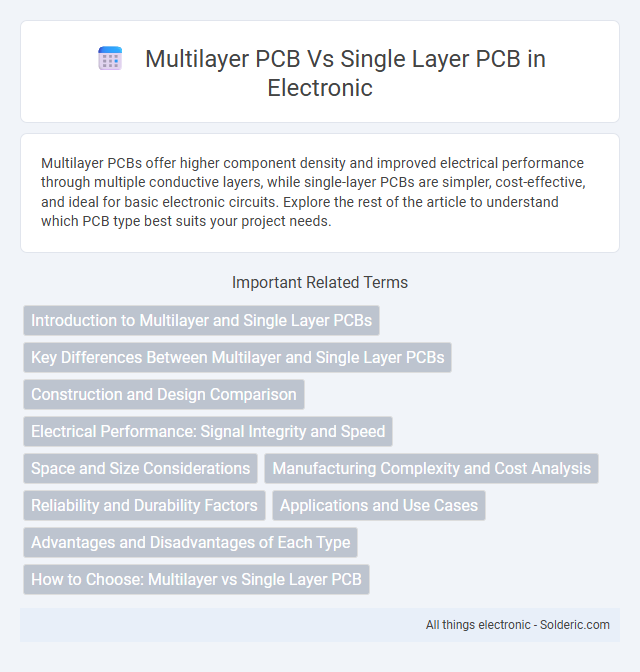Multilayer PCBs offer higher component density and improved electrical performance through multiple conductive layers, while single-layer PCBs are simpler, cost-effective, and ideal for basic electronic circuits. Explore the rest of the article to understand which PCB type best suits your project needs.
Comparison Table
| Feature | Multilayer PCB | Single Layer PCB |
|---|---|---|
| Layers | Multiple (3 or more layers) | One layer |
| Complexity | High, supports complex circuits | Low, simple circuit design |
| Size | Compact, saves space | Larger due to single layer routing |
| Cost | Higher manufacturing cost | Lower manufacturing cost |
| Performance | Better electrical performance, reduced noise | Suitable for basic applications |
| Durability | More robust and reliable | Less durable, prone to physical damage |
| Applications | Smartphones, medical devices, aerospace | Simple electronics, calculators, power supplies |
Introduction to Multilayer and Single Layer PCBs
Single layer PCBs consist of a single conductive copper layer etched on one side of the substrate, ideal for simple circuits with minimal components and straightforward routing. Multilayer PCBs feature multiple stacked layers of copper and insulating material, allowing higher circuit density, enhanced electrical performance, and reduced circuit size for complex electronic devices. The choice between multilayer and single layer PCBs depends on design complexity, signal integrity requirements, and physical space constraints.
Key Differences Between Multilayer and Single Layer PCBs
Multilayer PCBs feature multiple interconnected layers of conductive material, offering higher circuit density and enhanced performance for complex electronic devices compared to Single Layer PCBs, which contain a single conductive layer. The increased layers in Multilayer PCBs allow for improved signal integrity, better heat dissipation, and compact designs critical in advanced applications like smartphones and aerospace systems. Your choice between these PCB types impacts manufacturing cost, durability, and functionality, with Single Layer PCBs suited for simpler, cost-effective projects while Multilayer PCBs support sophisticated, high-performance circuits.
Construction and Design Comparison
Multilayer PCBs consist of three or more conductive layers separated by insulating materials, enabling complex circuit integration within a compact design, whereas single-layer PCBs have only one conductive copper layer attached to a non-conductive substrate. The construction of multilayer boards involves precise lamination of multiple layers for improved signal routing and reduced electromagnetic interference, offering higher circuit density compared to the simpler, less expensive single-layer designs. Design-wise, multilayer PCBs support advanced applications requiring high-speed signals and thermal management, while single-layer PCBs are suited for straightforward electronic devices with basic circuitry.
Electrical Performance: Signal Integrity and Speed
Multilayer PCBs offer superior electrical performance compared to single layer PCBs due to their enhanced signal integrity and higher speed capabilities. The multiple layers enable better controlling of impedance, reduced electromagnetic interference (EMI), and minimized crosstalk, essential for high-frequency and high-speed signal transmission. Single layer PCBs often face limitations in speed and signal clarity due to longer signal paths and less effective noise shielding.
Space and Size Considerations
Multilayer PCBs save valuable space by stacking multiple circuitry layers within a compact footprint, making them ideal for complex devices where size constraints are critical. Single layer PCBs, limited to one conductive layer, require more surface area to accommodate all circuit paths, leading to larger overall dimensions. Your choice between multilayer and single layer PCBs directly impacts the device's miniaturization potential and design flexibility.
Manufacturing Complexity and Cost Analysis
Multilayer PCBs involve complex manufacturing processes including precise alignment, lamination, and drilling through multiple layers, resulting in higher production costs compared to single-layer PCBs. Single-layer PCBs feature simpler designs with only one conductive layer, making them cost-effective and easier to produce but limiting circuit density and functionality. Choosing between the two depends on your project's requirements for complexity, performance, and budget constraints.
Reliability and Durability Factors
Multilayer PCBs offer superior reliability and durability compared to single layer PCBs due to their multiple insulating layers that reduce electromagnetic interference and thermal stress. The enhanced structural integrity of multilayer PCBs supports complex circuits and high-density components, making them ideal for demanding applications where longevity is critical. Your choice of multilayer PCB ensures better performance under harsh environmental conditions, extending the lifespan of your electronic devices.
Applications and Use Cases
Multilayer PCBs are extensively used in complex electronic devices such as smartphones, medical equipment, aerospace systems, and high-performance computing due to their ability to support dense circuitry and multiple signal layers. Single layer PCBs are typically found in simpler electronic devices like power supplies, LED lighting, and basic household appliances where fewer components and lower complexity are required. Industries demanding miniaturization and high-speed signal transmission favor multilayer PCBs, while cost-effective, straightforward applications rely on single layer PCBs for efficient functionality.
Advantages and Disadvantages of Each Type
Multilayer PCBs offer higher circuit density and improved performance by accommodating complex designs within a compact space, but they come with increased manufacturing costs and more difficult troubleshooting. Single layer PCBs are simpler to produce and cost-effective, making them ideal for basic electronic circuits, though they lack the capability to support intricate circuitry and limited component placement options. Your choice between multilayer and single layer PCBs depends on the complexity, budget, and performance requirements of your project.
How to Choose: Multilayer vs Single Layer PCB
Choosing between multilayer and single layer PCBs depends on your project's complexity and space constraints. Single layer PCBs are ideal for simple circuits with limited component density, offering easier manufacturing and lower cost. Multilayer PCBs support complex designs with multiple circuits stacked in layers, providing higher performance and compact size for advanced applications.
Multilayer PCB vs Single Layer PCB Infographic

 solderic.com
solderic.com